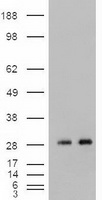Noggin (NOG) Mouse Monoclonal Antibody [Clone ID: OTI1C1]
CAT#: TA500116S
Anti-Noggin (Noggin) mouse monoclonal antibody, clone OTI1C1 (formerly 1C1)
Size: 100 ul
Frequently bought together (3)
Other products for "NOG"
Specifications
| Product Data | |
| Clone Name | OTI1C1 |
| Applications | IF, IHC, WB |
| Recommended Dilution | WB: 1:40000, IHC 1:50, IF (1:100) |
| Reactivities | Human, Mouse, Rat |
| Host | Mouse |
| Isotype | IgG2b |
| Clonality | Monoclonal |
| Immunogen | Recombinant protein expressed in E.coli corresponding to amino acids 28-232 of human noggin |
| Formulation | PBS (pH 7.3) containing 1% BSA, 50% glycerol and 0.02% sodium azide. |
| Concentration | 1 mg/ml |
| Purification | Purified from mouse ascites fluids or tissue culture supernatant by affinity chromatography (protein A/G) |
| Conjugation | Unconjugated |
| Storage | Store at -20°C as received. |
| Stability | Stable for 12 months from date of receipt. |
| Predicted Protein Size | 23.7 kDa |
| Gene Name | noggin |
| Database Link | |
| Background | Noggin is a secreted polypeptide which binds and inactivates members of the transforming growth factor-beta (TGF-beta) superfamily signaling proteins, such as bone morphogenetic protein-4 (BMP4). By diffusing through extracellular matrices more efficiently than members of the TGF-beta superfamily, it may have a principal role in creating morphogenic gradients. Noggin appears to have pleiotropic effect, both early in development as well as in later stages. The results of the mouse knockout of the ortholog suggest that noggin is involved in numerous developmental processes, such as neural tube fusion and joint formation. Recently, several dominant human NOG mutations in unrelated families with proximal symphalangism (SYM1) and multiple synostoses syndrome (SYNS1) were identified; both SYM1 and SYNS1 have multiple joint fusion as their principal feature, and map to the same region (17q22) as this gene. All of these mutations altered evolutionarily conserved amino acid residues. The amino acid sequence of this human gene is highly homologous to that of Xenopus, rat and mouse |
| Synonyms | SYM1; SYNS1; SYNS1A |
| Reference Data | |
| Protein Families | Druggable Genome, Secreted Protein |
| Protein Pathways | TGF-beta signaling pathway |
Documents
| Product Manuals |
| FAQs |
Resources
| Antibody Resources |
{0} Product Review(s)
0 Product Review(s)
Submit review
Be the first one to submit a review
Product Citations
*Delivery time may vary from web posted schedule. Occasional delays may occur due to unforeseen
complexities in the preparation of your product. International customers may expect an additional 1-2 weeks
in shipping.






























































































































































































































































 Germany
Germany
 Japan
Japan
 United Kingdom
United Kingdom
 China
China















